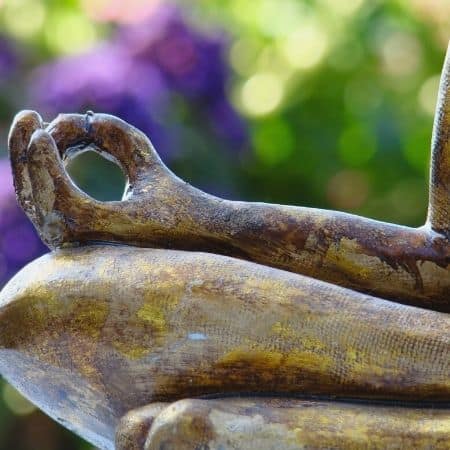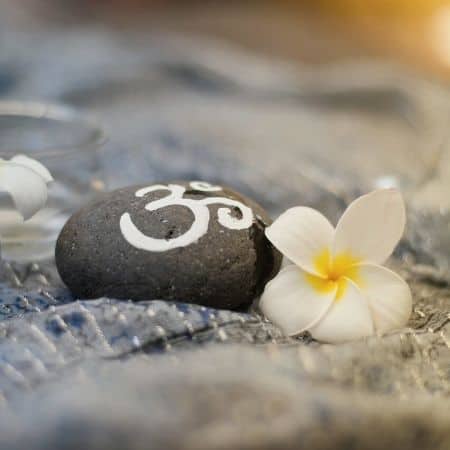You have finally acknowledged that meditation is good for you. Yet, you find it difficult to practice because you can’t get a grip on your wandering mind. One of the most effective ways to silence the noise in your head is to use mantras. But what are they, and how do you get them?
Mantras are sounds (words) you repeat that get you in touch with your unconscious. To start with, find yours by taking your cue from others’ mantras. Choose the one you feel is right for you, work with it for some time, then decide whether to keep it or switch to an appropriate one.
In this blog post, we will find out more about mantras and how to choose one that will help you improve your meditation practice for the better.
What Is a Mantra?
A mantra is a word, phrase, sound, or prayer you repeat to yourself that enables you to reach your unconscious mind. You “vibrate” mantras by chanting them, saying them out loud, listening to them, or repeating them through mental practice.
Mantra is a Sanskrit term with roots in different Eastern religions, but especially in Hinduism and Buddhism. The root word “man” means “to think.” The suffix “tra” comes from “trai,” meaning “to safeguard,” or “to free from the shackles of the mind.” The late 18th century Sanskrit definition is “a thought behind speech or action,” per the New Oxford American Dictionary. Another way of putting it is that it is a tool of the intellect.
It is common to hear mantras chanted in Sanskrit. You can chant mantras in any language, but certain languages (such as Gurmukhi in Kundalini yoga) are believed to be more effective in delivering focused spiritual and psychological benefits. Guru-mukh means “from the teacher’s mouth.”
What Does a Mantra Do?

Simply put, a mantra is a concentration aid used in meditation, although it is much more than that. A mantra generates beneficial vibrations within the body, frees the mind of mental debris, and zaps negativity.
Done silently—a mantra helps you stay connected to your breathing, allowing you to be more involved when practicing yoga, mindfulness, and/or meditation. Chanting mantras stretches your patience, expands your ability to focus, and enhances your skill in listening.
Mantras are used to unravel hidden capabilities. When we focus on them, disregarding everything else, our minds become serene, allowing us to reveal whatever is concealed.
Mantras enable us to mesh our identities with them. Studies have shown that language influences our thoughts, which, in turn, mold our personalities. So choose mantras according to the qualities you want to cultivate. Use the power of words to improve yourself.
As human beings, we all walk different paths in life. At some point, we lose our way, become disgruntled, get sad, experience failure, or doubt ourselves. Assigning a mantra gives us a sort of “reboot point” to return to, focus on, and from which to derive strength.
Benefits of Mantras
According to Amarjit Singh of Do You Yoga, these are some of the benefits of chanting mantras:
- It helps you concentrate. It directs your attention to the important stuff. It is particularly useful for many people who find it difficult to meditate because their thoughts run amok during sessions.
- It galvanizes the endocrine system. Reciting mantras causes your tongue to press against the roof of your mouth, which has 84 meridian points—pathways where vital energy flows. This action invigorates the pituitary glands, the thalamus, and the hypothalamus.
- Vibrations from recitations spread hormones and chemicals to the brain and the entire body. These are essential in balancing the biological system and contributes to healing.
- It releases pent-up emotions. Repressed feelings give rise to unpleasant sensations or unhealthy cravings. When you react to these, you create a pattern. Chanting mantras helps to break these through self-expression via the heart and throat chakras. (More on these below.)
- It promotes self-awareness. Vibrations from mantras are said to alter the composition of the body’s molecules.
- It helps you get in touch with the intangible and the infinite through adjustment of vibration. You tune into something by vibrating it. For example, when you vibrate joyfulness, you tune into it.
- It helps overcome karma by changing negative vibrations into positive ones.
How Do Mantras Work?
Every mantra generates a sound with a distinct vibration that delivers a specific effect. Spiritual leaders and yogis claim that mantras control the vibration of the components that make up your being. That’s why they are essential components of yoga and meditation.
Every vibration generated by a mantra has a strong impact on your consciousness. Feelings, words, thoughts, and actions do the same thing.
When you think negative thoughts, you create emotional and physical vibrations. The longer you let these linger, the greater they affect your being. They become habits, which turn into patterns to which you react. You may or may not be aware you’re doing so. Chanting mantras prevent these patterns from settling in.
When you consult a practitioner of alternative medicine because of an illness and says you have a block that might be its cause, he is talking about parts of the body where vibration is misaligned or moving slower than it’s supposed to. A block can also mean an obstruction in the life force’s flow (or vital energy).
How to Capitalize on the Benefits of Vibration
If you want guidance on how to harness the power of vibration better, you may want to try Naad yoga. Ask your yoga teacher how the occurrence of sound vibrations affect you. Singh explains the practice thus: Naad stands for the ethos of sound, while yoga stands for the union.
Naad yoga uses sound vibrations to elevate the conscious mind and tune in to Anahat, the term for the continuously vibrating universal sound, or that which Hindus believe started creation.
They also believe that the more sensitive you are, the more intense your experience of the vibratory effects. If you are not as intuitive, set aside a longer period for mantra chanting. Motivate yourself to focus more on the chant. This will ensure your practice will have a greater impact on your consciousness.
How Do You Find Your Mantra?

Search for your mantra by asking yourself what you want and need in your life, keeping in mind the difference between want and need. Take stock of your current problems and list possible solutions. Know your strengths and weaknesses. If you need to allay your fears, call on bravery. If you feel deflated, call on confidence. If you are exhausted, call on energy. If you feel frail, call on strength.
Try not to get stuck on one mantra. Seek out new mantras and see if they fit in with your experiences and emotions.
Autosuggestion is the technique for proper externalization of one’s mantra. It fools your subconscious to believe that you have already achieved whatever you are planning or are experiencing the event or state you desire. The rest will follow.
Jennifer DeSimone, leader of the U30X community, suggests these methods to find your mantra:
- Seek influences and inspiration from others before you.
- Change your mindset and the way you speak to yourself. Treat yourself with kindness, instead of berating yourself for past wrongs or results gone awry because of your decisions.
- Commit to a chosen mantra for a set period. Delve deep enough into it until a relationship evolves from it. It may not be your ideal, but it will start serving you after a while.
- Repeat your chosen mantra for about 20 times in a session. Your mind will naturally wander (unless you’re a master yogi or a very disciplined individual). When this happens, return to the mantra. If you lose it temporarily, forgive yourself. Simply repeat the mantra.
- Allow yourself to unite with your mantra. Surrender yourself to it, especially in times of strife and misery.
Seven Mantras for Seven Chakras
A chakra is a focal point of spiritual power in the human body. The word originates from the Sanskrit “cakra,” meaning “circle or wheel.” Every chakra is represented by a color that endorses and nurtures each one’s characteristics, mood, and energy. Seven essential mantras go with the seven chakras.
Suraya Sam, the founder of Ascend Yoga Therapy, outlines these mantras for the seven chakras. The chakras are listed in the order they are encountered in the body (from top to bottom):
- “I understand” for the Crown—reflects the relentless pursuit of knowledge. The Crown chakra puts us in touch with our higher self and beyond.
- “I see” for the Third Eye—enables us to discover the boundless potential inherent in us without the aid of regular vision.
- “I speak” for the Throat—symbolizes communication with others and expression of one’s true self.
- “I love” for the Heart—represents compassion, reflection, connection, and nurturing.
- “I do” for the Solar Plexus—instigates movement, triggers direction, and activates zeal.
- “I feel” for the Sacrum—makes us aware of passion, emotions, and the quest for gratification.
- “I am” for the Root—the ground level chakra symbolizes foundation. It strengthens our bond with nature and our innate human qualities.
Why Is It Essential for a Mantra to Be Positive?
Whatever you choose for your mantra, it has to be positive because words have energy in them. They produce emotions and memories. Negative ones can get stuck in our minds and bodies if we are not careful. These are difficult to get rid of once they have found their way in the inner recesses of our being. They are partly responsible for making psychiatrists and other paid mental health professionals richer.
This is why cultivating positive thoughts and externalizing them are important. Thinking positively leads to speaking positively. Practitioners of Sadhana believe that even just one negative word or phrase, which emits low vibration, could thwart the spirit and intent behind the practice.
According to the Oxford Dictionary of English, Sadhana means “disciplined and invested education or practice, particularly in music or religion.” It comes from the Sanskrit term, which means “dedication to an aim.”
The practice of mindfulness helps us realize how words affect people. It encourages us to think in a positive light. To achieve this, we should strive to recognize the good in everything and everyone.
Proof That Mantras Work
Dr. Masaru Emoto conducted an experiment on water crystals, which revealed that written or spoken affirmations, prayers, and chants could alter the molecules that compose water. He found that positive words produce well-proportioned water crystals, while negative ones produced misshapen crystals.
The logic was that, if the intent and the spirit of words have beneficial effects on water, what more on our minds and bodies, considering that 50-60% of the human body consists of water?
What Is the Most Powerful Mantra?
According to Wikipedia, the Gayatri mantra is one of the global Hindu mantras. It’s like an across-the-board citation. Hindus use it to invoke the universal Brahman as the primary source of knowledge and the radiance of the primeval Sun. In Hinduism, Brahman is the origin of all visible forms.
The Gayatri mantra can be found in the third book of the Rigveda, the most ancient and preeminent of the Vedas, an anthology of 1,028 early Sanskrit hymns formulated in the 2nd millennium BC.
What Is the Universal Mantra?

Mantras are assortments of sounds based on the rate of occurrence of each sound’s vibration. Every word (or each letter in a word) produces a specific frequency connected with a particular chakra in the body’s energy network. When you chant a mantra, you achieve symmetry and consonance in the chakra associated with it.
Akhanda Yoga explains that mantras correlate with the way traditional medicine is dispensed. Gurus give their students some mantras like prescription medicine, tailored specifically for those students’ ailing chakras. Other mantras are like over-the-counter medications that may be used by anyone without being guided by a guru. These are what they call “universal mantras.”
Akhanda Yoga’s Yogrishi Vishvketu suggests this universal mantra: “Akhanda mandala karam.” It means, “The cosmos and the manifest universe are one indivisible entity.” Use it when you feel disengaged from your community or feel that society is being hard on you. This mantra reminds us that our emotions do not make the individual. It promotes affinity with groups and a sense of belonging.
Although you can chant this mantra any time (up to 21 times in succession), Vishvketu suggests doing so early in the morning prior to meditating or practicing yoga. After chanting, reflect on the mantra’s significance.
What Is a Positive Mantra?
It is a tool for soul-searching and achieving tranquility. You repeat positive words, phrases, or statements to yourself that report a particular result, describe an achievement of a goal, or reflect a state you desire. In the beginning, these affirmations may sound convoluted, even silly, because they are not necessarily true.
However, when you say these mantras repeatedly, your subconscious mind will slowly pick up on them and eventually find truth in them.
What Is a Life Mantra?
Also called a personal mantra, a life mantra is a word, phrase, or statement used to inspire and motivate people to be the best version of themselves. It is a guide to living one’s life and achieving goals.
It offers tremendous support for those whose relationships have ended, are stressed out, are experiencing inner turmoil, are mired in financial setbacks, are in the midst of a crisis, or find themselves at a crossroads.
Is There a Mantra for Good Health?
Yes, it is called the Dhanvantri mantra. Chant it to eliminate medical ailments from the body and rid the soul of psychological illnesses.
In Hinduism, Dhanvantri is the Deity of Medicine and a personification of Lord Vishnu, the Supreme Savior. Hindus believe that in every instance of reciting this mantra, part of its sacred quality blesses the chanter. Beneficial effects are greater, the more the practitioner chants.
Spiritual leaders recommend preparing your mind before chanting. Boost your confidence with an affirmation, such as, “This disease is leaving my body. I enjoy optimum health right away.” This move strengthens your will and reinforces the power of this mantra.
What Is the Money Mantra?

A money mantra is an influential, potent phrase or sentence recited loudly to yourself to draw affluence and prosperity into your life. Recite it three times a day (or more, if you have the time and inclination). Believe in this mantra even if you have initial doubts. When you are motivated enough, and your intention is pure, your financial status will change.
Money mantras (as with others) cause the law of reciprocity—a mutual exchange between parties where everyone benefits—to occur. Be specific about your mantra. If you need a particular amount, don’t be ashamed to write it down and say it.
Unless you’re chanting as a part of a class, only you can hear your mantra. Specify where you want your windfall to appear. Incorporate pertinent details in any mantra. Make chanting part of your daily regimen.
Life coach Stacia Pierce claims that money mantras helped get her out of her financial rut at a time when she was living paycheck-to-paycheck and had difficulty paying bills. She suggests these five mantras that positively changed the direction of her life and which you can use to attract more money or gain financial freedom:
- For the constant influx of positive finance: “Money arrives in my life at all times.”
- To lighten the mood when working: “Making money is a breeze!“
- To make the most of relationships: “Each person I meet cares about me, contributes to my success, and presents me with financial gain.”
- To motivate others to help you achieve your goal: “Money flows in naturally and without obstacles. The people I assist reciprocate by compensating me on time.“
- To uplift your spirits: “I have the right to enrich my life. I deserve more. I always have room for abundance.“
Note: Stacia’s mantras were slightly amended, but the intentions remain the same.
Forms of Mantras and How They Affect the Psyche
Mantras exist in many forms, such as musical chants and verses with melodious meters configured mathematically. Gurus believe they pulsate with divine characteristics.
The “om” is a mantra in its simplest form. More sophisticated forms of mantras include melodious phrases that interpret in a spiritual manner intangible concepts like love, enlightenment, peace, and the search for truth. Examples of these mantras are verses published in the Rigveda. Other mantras that don’t have literal interpretations but hold spiritual significance uplift the soul in a musical manner.
Experts believe that mantras, such as the “om,” generate positive reverberations that clean and sanitize the chanter’s surroundings. They also help the practitioner achieve the Alpha state, a meditation level where one experiences profound relaxation.
Four Simple Mantras for Beginners

- The sacred “om” or “aum” sound is also a spiritual symbol used by religions in India (including Buddhism, Jainism, and Hinduism). It is believed to be the first sound uttered on our planet. It means “the internal self or the soul.” It generates a vibration that calms the mind and body.
- The “Ham Sah” mantra, which originated from Kriya yoga, generates fearlessness. “Ham” means “power,” and “sah” means “awareness.” Inhale with ham and exhale with sah. This mantra offers both spiritual and physiological advantages. An example of the latter is it boosts one’s breathing capacity.
- The “Om Namah Shivaya” mantra originates from the Vedas, ancient Hindu scripture. The phrase means “devotion to Shiva, the Supreme Being.” Spiritual leaders regard this mantra as a form of sound therapy for the mind and body. Use this mantra if you want to invoke peace and happiness in your life. This mantra calls for the elimination of the ego and the pursuit of virtue.
- The Gayatri mantra mentioned above is a prayer for peace and a request to the Creator for wisdom and insight. This mantra is considered universal because it does not discriminate based on skin color, religion, or ethnicity. Anyone can use it in their practice.
Mantras vs. Affirmations
Both may be in the form of one word or an entire phrase. The distinction lies in how they are used. Affirmations motivate people, help banish negativity, and guard against self-destructive behavior. Mantras, on the other hand, have sacred significance. People recite or chant them within spiritual practice. Use both or interchangeably to improve your circumstances.
How Do You Create a Mantra?
- Determine what you require at this precise moment. Ask yourself, “What do I need to create tranquility in my mind and my life? Which positive actions, attitudes, or thoughts do I need more of?” Write them down.
- Gather the thoughts you’ve come up with and turn them into a positive statement that you can declare to yourself.
- Use “I” words or write in the first person. For example, “I am thankful for…” Or: “I am strong and unrelenting in the face of adversity.” Or: “I strive to be happy today, no matter what.“
Do not use negative words, like cannot, never, unable, and suchlike.
- Write your mantra in the present tense to give the illusion that you have already achieved the goal or are experiencing a positive event or state every time you read it.
- Customize the intent of your mantra according to your current needs. Use words that have a particular significance to you and your circumstance.
- Write down the positive statement on an index card or piece of paper and post it where you can easily see it every day. Carry it wherever you go. Or use it as a wallpaper on your phone, tablet, or computer.
- Read your chosen mantra out loud with emotion several times daily, or at least once after waking up and before going to sleep.
- Use your mantra to visualize the attainment of your goal. After doing this for some time, you will experience the benefits. Many people’s goals and intentions come to fruition with their mantra practice.
Can You Listen to Mantras Instead of Reciting Them?
It’s better to recite mantras than simply listening to them. That said, it also depends on the situation and the type of mantra. For instance, if you’re inside a temple and people are chanting, it’s helpful to listen for the calming benefits.
Also, if you want to listen to people who have been doing this for a long time and want to learn from them, then it is recommended for observation. It is expected, however, that you will also be proficient at your practice at some point.
Final Thoughts
The health and wellness industry generates billions of dollars annually as it promises the elixir of life to all who can afford it. Premier spas and similar establishments offer the illusion that transcendence comes at a price.
The truth is, anyone can revitalize the body and mind for free by meditating and reciting mantras. One just needs a bit of discipline, a sense of commitment, and some time each day for the practice. Our ancestors from the East have been practicing the concept of mantras for thousands of years. Join them in the path to enlightenment and rejuvenation.








